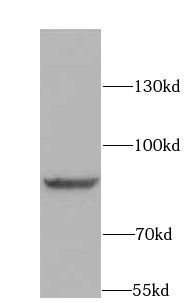Products
BRCA1 antibody
Category:
Research Area:
- SPECIFICATIONS
- Product Name
- BRCA1 antibody
- Catalogue No.
- FNab00942
- Size
- 100μg
- Form
- liquid
- Purification
- Immunogen affinity purified
- Purity
- ≥95% as determined by SDS-PAGE
- Clonality
- polyclonal
- Isotype
- IgG
- Storage
- PBS with 0.02% sodium azide and 50% glycerol pH 7.3, -20℃ for 12 months (Avoid repeated freeze / thaw cycles.)
Immunogen
- Immunogen
- breast cancer 1, early onset
- Alternative Names
- RNF53 antibody
- UniProt ID
- P38398
- Observed MW
- 85 kDa
Application
- Tested Applications
- ELISA, WB, IHC, IF
- Recommended dilution
- WB: 1:500 - 1:2000; IHC: 1:50 - 1:200; IF: 1:20 - 1:50
Validated Images
 human testis tissue were subjected to SDS PAGE followed by western blot with FNab00942(BRCA1 antibody) at dilution of 1:1000
human testis tissue were subjected to SDS PAGE followed by western blot with FNab00942(BRCA1 antibody) at dilution of 1:1000
 Immunohistochemistry of paraffin-embedded human breast cancer using FNab00942(BRCA1 antibody) at dilution of 1:100
Immunohistochemistry of paraffin-embedded human breast cancer using FNab00942(BRCA1 antibody) at dilution of 1:100
- Background
- This gene encodes a nuclear phosphoprotein that plays a role in maintaining genomic stability, and it also acts as a tumor suppressor. The encoded protein combines with other tumor suppressors, DNA damage sensors, and signal transducers to form a large multi-subunit protein complex known as the BRCA1-associated genome surveillance complex (BASC). This gene product associates with RNA polymerase II, and through the C-terminal domain, also interacts with histone deacetylase complexes. This protein thus plays a role in transcription, DNA repair of double-stranded breaks, and recombination. Mutations in this gene are responsible for approximately 40% of inherited breast cancers and more than 80% of inherited breast and ovarian cancers. Alternative splicing plays a role in modulating the subcellular localization and physiological function of this gene. Many alternatively spliced transcript variants, some of which are disease-associated mutations, have been described for this gene, but the full-length natures of only some of these variants has been described. A related pseudogene, which is also located on chromosome 17, has been identified.



